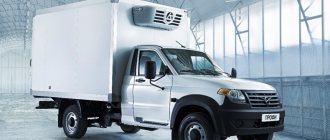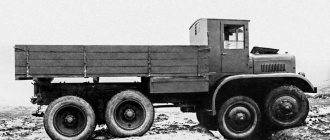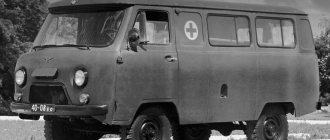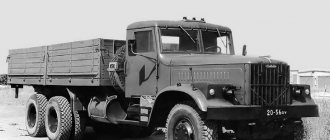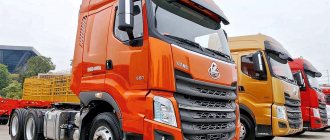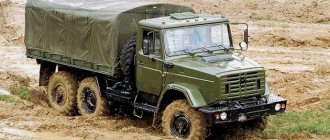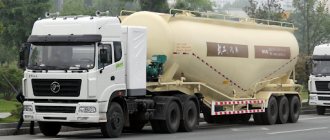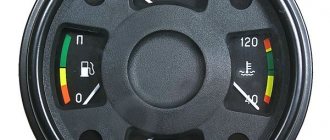Stanislav Kirilets Photos of Daimler AG, from foreign periodicals of the early twentieth century and the author’s archive
Polls about priority in automotive history are often quite scrupulous. And often the answers to them are given from a position of strength. We have long come to terms with the fact that the Germans Karl Benz and Gottlieb Daimler were the first to build a car with an internal combustion engine (ICE), although there are many contenders for this honor. Some of them are challenging the primacy quite rightly, but the aggressive advertising campaign carried out by the respected concern for more than 100 years has pushed all others into the background. And there is no one to stand up for them. However, we will now only consider trucks with all-wheel drive. Here the question of primacy is not yet closed. There were several answers to it, but almost all of them were incorrect.
Terminology difficulties
Another sensitive question: what is a car? This term appeared at the end of the 19th century, with the light hand of French journalists it quickly entered almost all European languages, despite the fact that it was received with hostility by many. Still would! An absurd word, the first part of which has Greek roots (αὐτός), and the second part has Latin roots (mobilis). It turned out “self-propelled”, which is how they were often called before: “self-propelled carriage”, “self-propelled carriage”, “self-propelled engine”, “self-propelled”... In Russia they quickly got used to the French term, “car” won the argument, however, without synonyms it didn't stay. Therefore, logically, a car is not only a vehicle with an internal combustion engine, but also with any engine. Then we will have to pay attention to self-propelled vehicles with steam and electric engines, which appeared much earlier.
Now it seems everything is simple. The terminology has long been established, there is GOST, there is the “all-knowing” Wikipedia... True, this topic is of concern only to certain colleagues. Many automotive history buffs are adherents of the “lookalike” community. They are mainly interested in what kind of Soviet car does the truck they have never seen before look like? There are other “sects” of various kinds. Among them is a faction of “picky” (let’s use a softened term) - pedants who vigilantly monitor the choice of words and the correct naming of models. The author of this article sympathizes with them.
At the suggestion of “creative” journalists and bloggers, terminology is constantly changing and not always for the better. The justification is the popular thesis: “The Russian language is developing.” Thus, almost everywhere, cars on combined railway tracks have recently begun to be called “locomobiles”, having forgotten the original meaning of this word. Logic: those locomotives (mobile steam engines, but trailed, horse-drawn) have sunk into oblivion, it’s a beautiful word, why not find a new use for it? Other colleagues are outraged by the new GOST, where instead of the correct term “windshield” the jargon “windshield” is written. But they can also call a three-wheeled mining dump truck the absurd, in this context, outdated word “tricycle,” hiding behind the same GOST. However, we digress.
In 1769, military engineer Captain Nicolas Joseph Cugnot, fulfilling an order from the French War Department, built a self-propelled tractor with a steam engine for transporting artillery pieces. Fortunately, no one disputes his priority. In fact, this was the first car, despite the fact that the word had not yet been invented. In Russian lexical usage, starting from the 19th century, steam tractors were called “steam carts”, “land steam locomotives”, “self-propelled locomotives”, “road steam locomotives”, “road steamers”, “road locomotives” or “routiers” (from the French routier - road or track; locomotive routière - road locomotive). Later - “steam tractors”, as well as “steam cars”. So, a steam tractor or a tractor is, in fact, also a car, it is impossible to refute this! Then let's start with them - let's move on to the topic.
GAZ-66
Shishigu cannot be ignored if the conversation turns to the cross-country ability of trucks. This vehicle was designed for landing. Running on two single axles, with a good chassis design, and good motor performance - all this gave Shishiga a huge advantage over off-road conditions. However, he was vulnerable to the virgin snow. In terms of price, this truck can be purchased from storage for a maximum of 400 thousand rubles. Or limit yourself to the used version for 250 thousand rubles.
Let's remember the routers
The priority in the construction of a self-propelled steam engine with all-wheel drive is also undeniable. It belongs to American inventor Oliver Evans, owner of the Mars Iron Works in Philadelphia. In 1804, by order of the city health department, Evans built an unusual unit - a self-propelled and floating excavator. Known under the names Oruktor Amphibolos and Amphibious Digger, the unique machine, 30 feet long and weighing 17 tons, was designed to clean up the riverbed. The design was outrageously simple and even primitive; the creator did not provide brakes and steering. And there was no need for such excesses; the amphibian reached the river along a straight road at a snail’s pace, but under its own power. The steam engine drove the wheels, propeller and boom of the excavator through a sequential belt drive. True, some sources claim that this event happened in 1805 or 1807. But the alternative dates do not contradict Evans’s merit; he is not only the creator of the world’s first all-wheel drive vehicle, but also the first amphibian. Can this unit be considered a car? He was driving, therefore, there is no reason to reject this statement!
In 1827 or so (there is a slight fluctuation in dates in different sources), English engineers Timothy Burstal and John Hill built a real all-wheel drive steam self-propelled vehicle, capable of moving not only along a straight road. On a regular stagecoach, Burstall and Hill installed an additional drive to the front axle, which at that time was still of an unusual type - a driveshaft.
Our compatriot Avksentiy Vradiy also distinguished himself. On June 26 [July 7], 1863, he received privilege No. 906 for a “steam locomotive for driving on ordinary roads.” The inventor took into account the condition of Russian roads and climate and developed two versions of the machine. One was a sleigh with an external gear, which was the propeller. And the second one is wheeled with all-wheel drive. The rear wheels were driven from the breaker shaft by means of connecting rods, and the front wheels were driven by chains. But the trouble is, no evidence of the construction of the steam locomotive Vradia was found. There were a great many interesting and daring mechanical transport projects in the Russian Land, but their implementation often left much to be desired - only in rare cases did the projects of domestic road locomotives go beyond the paper fields.
While routiers were being painted in Russia, the logical conclusion of the industrial revolution in England was their mass production. In the second half of the 19th century, road locomotives rolled out of the gates of British factories by the dozens, and then by the hundreds. The military circles of Europe became interested in them. Routiers were successfully used in the Crimean, Franco-Prussian and Russian-Turkish wars, but they were ordinary ones. Complaints were caused by their heaviness and poor maneuverability, even with various devices to increase it. The question has arisen about all-wheel drive. British and American industrialists responded to this with a number of new, very real and workable designs.
The picky reader will say: “Rooters and steam tractors are not really trucks.” Maybe. However, GOST is silent on this matter, but it considers modern ballast tractors to be such. Moreover, the routers also transported goods. And in the first half of the 20th century there was no clear boundary at all; any truck with a trailer was called a “car-tractor”. All-wheel drive trucks were then often considered tractors. What about the famous Unimog and others like it? By the way, some fellow writers have already come up with and are actively introducing a new term “tractor car” into use.
The Age of the Automobile
The appearance and victorious march of internal combustion engines and self-propelled vehicles at the end of the 19th century led the countries of Europe and North America to a new industrial revolution - the automobile revolution. The beginning of the 20th century can easily be called the entry of the world into the “age of the automobile.” The success of light self-propelled vehicles with internal combustion engines has prompted many manufacturers of steam and electric carriages and carts to try to keep up with progress and reconsider their concepts. In an attempt to stay ahead of the curve, they had to resort to innovation. At first, new designs of electric vehicles and steam vehicles (new terms appeared) were able to compete with gasoline engines.
If we accept the thesis that real cars appeared at that time, then we will have to send the routers back to prehistory and start the countdown again. Which is what is traditionally done. It is traditionally believed that the first car with a 4x4 wheel arrangement appeared in 1900, and it was the Austrian electric self-propelled Lohner-Porsche. Wrongly considered!
Back in 1895, the American company Charles F. Caffrey Carriage Co., specializing in electric vehicles. built a compact steam car equipped with four small 3 hp steam engines. every. The driver could regulate their operation separately and vary the power of the device from 3 to 12 hp. – each motor drove one wheel. Manufactured in a single copy, the universal car also claims priority in the front-wheel drive class, which it became when the rear wheel engines were turned off. Unfortunately, there is no one to protect the Caffrey Steam Wagon now, and a large concern is standing up for the Lohner-Porsche electric car that appeared later and supplanted its predecessor. After all, Ferdinand Porsche himself took part in its development! And the fact that he was at least 5 years late is of no interest to almost anyone. True, large companies have not yet taken credit for the construction of the first all-wheel drive car with an internal combustion engine in 1903. The Dutch six-cylinder 60-horsepower racing car Spyker (or Spijker, as they also wrote) still firmly occupies this position.
However, we are interested in trucks. Especially for those who stubbornly refuse to recognize steam tractors as trucks, we will separate cargo platforms into a separate class, but we will not divide them by type of power unit. In this class, priority for the 4x4 formula was again undeservedly given to Austria-Hungary, despite the fact that it belongs to France.
The first classic 4x4 trucks
In 1897, the leading automobile power France held the Poids Lourds competition for cargo trucks and omnibuses. It involved cars of a wide variety of concepts and designs. The lists also included one very unusual truck - a steam-powered one with all-wheel drive. Back on June 6, 1896, the Parisian inventor Julien Gandon (I explain to some readers - this typical French surname coincides with our obscene word by chance) filed an application for a patent: “Improvement of mechanically driven units: transmission of force to the four wheels of a road vehicle.”
It is not known exactly when the Gandon steam freight locomotive was ready, but in 1900 it was shown at an exhibition in Paris. Almost no one noticed him there and did not appreciate the significance of the innovative concept. And only the American magazine The Horseless Age published a note with a photograph of the truck in its August issue, preserving its appearance for posterity. The steam engine of the 3-ton truck produced 12 hp. The boiler with a kerosene firebox was located to the left of the driver. The transmission included four clutch units and six drive chains. The driver could, if necessary, switch off the front or rear wheel drive. The self-propelled vehicle was accompanied by a trailer with a carrying capacity of two tons. The road train could reach speeds of up to 12 km/h. This wise design had no future, but it is Gandon that claims the right to be considered the first all-wheel drive flatbed truck.
Until now, the Austrians and Hungarians have claimed priority in all-wheel drive for trucks. It turned out that they only apply for the category of cars with internal combustion engines. However, we must give them their due; their developments laid the foundation for a new class of cars - all-wheel drive all-terrain vehicles. In 1903, Captain of the Austrian General Staff Ludwig Tlascal von Hochwal created a sketch of an armored car, and a year later, together with engineer Gyula Koroknai, he developed for the Rába plant, Magyar Vagon–és Gépgyár (Ungarische Waggon- und Maschinenfabrik AG, Raab) an all-wheel drive truck, the design of which served as the basis for the construction of a family of special 4x4 chassis. The expert was none other than Ferdinand Porsche, but it is possible that this is just a legend. Some colleagues, not without reason, believe that the role of this designer in the early history of the car is somewhat exaggerated. Be that as it may, there was a sensation!
The Raba tractor equipped with a 40-horsepower engine with a short platform and winch was manufactured in 1904. All wheels of the car were not only driven, but also steered. The massive wooden wheels, covered with protective caps, were equipped with wide-profile iron tires; if necessary, special hoops with lugs were put on them. The Austrian War Ministry successfully tested the vehicle on highways and off-road; it freely traversed difficult sections of the road even with five loaded trailers. High military officials approved the idea and expressed a desire to purchase several vehicles of this type, including an armored car. But... they entrusted this work to another plant.
The best long-haul tractors
First, let's look at the new saddle trucks, which are designed for long-distance transportation of various categories of goods throughout Russia and beyond.
At the same time, it cannot be said that these are full-fledged new products, since updates among Russian trucks are not released as often as in the passenger vehicle segment.
We tried to select the latest and most interesting cars.
Since these are long-haul models and the challenge is to select the best Russian high-quality trucks, this category is completely dominated by KAMAZ. Alas, other domestic factories have failed to create worthy competitors for KAMAZ. Whether this is good or bad, judge for yourself.
- KAMAZ 5490. Still a current model. But these are definitely not new items among Russian trucks. The car debuted back in 2011 at a special exhibition. But mass production started in 2013. It has an all-metal cabin, attractive design and electric tilting. Load capacity is over 10 tons. The total weight here is 18600 kg. Comes with 2 motors to choose from. Both comply with Euro 5 standards. One engine from Mercedes for 12 liters and 401 hp. s., and the second from Daimler with the same volume, but with a power of 428 horsepower. Equipped with a 16-speed synchronized manual transmission. But optionally you can install a 12-speed automatic transmission.
- KAMAZ 5490 Neo. Another long-haul tractor, and this is the company’s flagship. Has a 4x2 wheel formula. Designed to work as part of a road train weighing up to 44 tons. The prefix Neo means new. The debut took place in the spring of 2022. The modernization made it possible to increase the wheelbase, optimize weight distribution along the axles, improve the suspension and increase the volume of the fuel tank. Plus a number of modern options have been added. This is also one of the most beautiful trucks, developed by domestic specialists. The weight is 7900 kg, and the total weight reaches 18.6 tons. A well-thought-out cabin allows you to travel long distances in comfort. Only one engine is available for the restyled truck. This is a 12-liter 401-horsepower engine. By default it comes with a 16-speed manual transmission. For an additional fee, KAMAZ offers to install a 12-speed automatic transmission. The manufacturer claims a consumption of 33 liters per 100 km.
- KAMAZ 65206. Considered one of the best projects of the 21st century performed by the KAMAZ plant. We are talking about a three-axle mainline tractor. Designed for interregional and international transport. It has a modern cabin, stylish design, and a significant amount of free space inside. There is only one sleeping place. But with increased comfort. The ergonomics are exemplary. Not all imported analogues can offer something similar. Curb weight depends on the configuration, but is about 9.2 tons. Load capacity is up to 16.7 tons. Here we are talking about the load on the SSU. The vehicle is capable of towing a trailer with a total weight of up to 34.7 tons. Under the conventional hood is a 6-cylinder turbocharged diesel engine from Daimler with a volume of 11.7 liters. But the power depends on the modification. The S5 version produces 401 horsepower, while the T5 produces 428 horsepower. You can choose from an automatic or manual transmission with 12 and 16 gears, respectively.
- KAMAZ NEW 5460. In 2010, they presented an updated version of the most popular two-axle mainline tractor in the KAMAZ production line at that time. Due to modernization, the vehicle received a new all-metal cabin and improved air suspension. The interior has also been significantly improved, raising comfort to a new level. A high roof and 2 sleeping places appeared. This tractor has become an excellent choice for intercity and interregional flights. The load on the saddle was 8.7 tons. The total weight here is 16.2 tons, and the towing capacity with a semi-trailer has reached 32.5 tons. Under the new cabin there is also a new engine. This is an 8-cylinder turbodiesel of 11.75 liters with a power of 420 horsepower. The transmission is exclusively automatic, with 12 speeds.
- KAMAZ NEW 65116. This is a three-axle modernized large-tonnage truck. It features improved technical and parameters. The car has a new comfortable cabin. The updates made it possible to reduce the curb weight to 7.2 tons, that is, minus 500 kg. On the contrary, the carrying capacity has increased by 500 kg, and is now 15.5 tons. Now the tractor can pull a semi-trailer with a total weight of up to 30.5 tons. The car is powered by a 6.7-liter turbocharged diesel engine from Cummins. Thanks to the turbine and direct injection, the power was increased to 281 horsepower. The internal combustion engine operates in tandem with a 9-speed manual transmission.
Now, in 2022, the production of all these trucks continues actively in Russia. At the same time, KAMAZ soon promises to present a new line of its vehicles. These will include updated and completely new mainline tractors. So we are looking forward to it, and we will certainly update the current rating.
From Austria to Germany
Based on Tlascal's ideas, the head of the Austrian plant Oesterreichische Daimler-Motoren-Commanditgesellschaft (a branch of the German company Daimler-Motoren-Gesellschaft) Paul Daimler and engineer Paul Stahl developed projects for which the construction of two all-wheel drive tractors and one armored car was completed at the beginning of 1905. They are considered, not entirely correctly, to be the world's first functional all-terrain vehicles. They were built according to the same scheme, the main differences were only in dimensions and purpose. The front axle was driven by a cardan, and the rear axle was equipped with a Ritzelantrieb gear drive, typical of Daimler trucks of that time. True, the compact and relatively light armored car should not be confused with a truck. Engines with 30, 35 or 40 hp. made it possible to accelerate cars to a speed of 24 km/h and take climbs with an elevation angle of up to 25°.
All three vehicles were tested at imperial maneuvers in Austria-Hungary. The Austrian War Ministry was going to purchase an armored car and even paid a deposit of 500 crowns, but apparently the price of 27,000 crowns seemed too high to the military and they refused the purchase. In November of the same year, the armored car was shown at an exhibition in Berlin in the hope of selling it to the Germans. Those, obviously, were also put off by the high cost. After being demonstrated at an exhibition in Paris in December 1906, it was acquired by the French. The tractors entered the Austrian army, where they served regularly until the very end of the First World War. There were no further orders, development was stopped until 1908, and the license was sold to the French.
At the end of 1905, Paul Daimler returned to Germany, the place of chief designer in Austria was taken by the aforementioned Ferdinand Porsche, who began to stubbornly promote his concept of an electric transmission (this fixed idea did not leave him almost all his life). A situation of internal competition has developed at the plant. For a long time, work was carried out on all-wheel drive vehicles in two directions. One of them turned out to be a dead end - the one promoted by Porsche. The First World War put a heavy end to it.
Austrian Daimler all-terrain vehicles served as the starting point for the formation of the classic layout of all-wheel drive and armored vehicles of the early twentieth century throughout the world, but to varying degrees. The designers of all-terrain vehicles were guided by the chassis, and the creators of armored cars took an armored hull with a rotating machine-gun turret as a model. As for all-wheel drive, the Austrians' solution turned out to be ideal; soon the parent concern Daimler in Germany seized the initiative and continued working in this direction. In September 1906, the self-propelled command of the Royal Prussian Army received two special army all-wheel drive Daimler-Marienfelde trucks, which were tested in German South-West Africa.
In 1907, by order of the German Imperial Colonial Office, a passenger car with all driving and all steering wheels was built at the Daimler-Marienfelde plant. He was sent to South West Africa at the disposal of the police there. The state secretary of the department, Bernhard Dernburg, took part in a test run through the Kalahari Desert - in his honor, 100 years later, Daimler AG named the SUV Dernburg-Wagen. Around the same time, the term Geländewagen appeared in German; it can be literally translated into Russian as “a cart for the area.” The bulky machine was presented to the Prussian War Ministry, but it refused the complex and expensive equipment. Through St. Petersburg, the Germans tried to offer such cars to the Military Department of the Russian Empire. But the Russians showed no interest either. The only car did not work in this form for very long; in 1911, due to the complexity of maintenance and repair, the driving front axle was replaced, and the wheel arrangement became 4x2. It can be considered the first passenger SUV in the world. The concern claims that it was “The first passenger car with all-wheel drive for everyday use.” Excuse me, but what about the design of F. Porsche and other contenders for this title?
Leading manufacturers
This will not be a ranking format, but rather an introduction to interesting, high-quality and interesting companies that form the backbone of the Russian automotive industry.
- Kamaz. The KAMAZ company is considered the undisputed leader on the Russian market. The company is actively increasing its production, producing a whole series of various trucks, which are sold not only in Russia, but also in many other countries. In 2022, KAMAZ does not lose its relevance, coming up with new ideas and introducing advanced developments. This company occupies approximately a third of the truck market. Moreover, KAMAZ was created relatively recently, but in a short period of time the brand managed to gain international recognition and undeniable authority. KAMAZ was created precisely with the goal of replacing imported freight transport in the USSR, which was sorely lacking and which was too expensive. The company is organized in Naberezhnye Chelny. As a result, KAMAZ became a city-forming enterprise.
- MAZ. Although this is a Minsk plant, it was founded in the USSR back in 1994. A huge contribution to development was made by Russian engineers. Therefore, Belarusian cars can rightly be considered a product of the domestic automobile industry. MAZ rapidly increased its production speed. Now about 10% of the entire Russian truck market is occupied by vehicles of this brand. MAZ vehicles are distinguished by increased reliability and a high level of quality. Plus, recently it has been possible to significantly increase the level of manufacturability, environmental friendliness and efficiency.
- URAL. The company was also created at the beginning of World War II. At that time, the Soviet army was in dire need of transport, and therefore no one thought much about functionality. Therefore, for the production of cars they took everything that was at hand. Currently, URAL trucks are high-tech, they are distinguished by increased maneuverability, exemplary reliability and the ability to work in the most difficult conditions. The share on the Russian market is approximately 5%.
- GAS. We are talking about the Gorky Automobile Plant, which produces freight and passenger transport. The company's product range is huge, which allows it to cover the needs of an impressive number of consumers. Moreover, it is also the oldest company, which was founded in 1929 with the assistance of Ford. GAZ is rightly called an undervalued brand. Despite its objective advantages, the prevalence of cars of this brand is not as serious as that of other domestic developers.
- ZIL. If anyone can surpass GAZ in terms of age, then only ZIL. The company was founded in 1916. For more than 100 years of its existence, the company has managed to ship about 700 thousand cars to 50 countries around the world. At the same time, a huge number of trucks were sold on the local market. ZIL machines are distinguished by their ease of operation, exemplary reliability and low operating cost.
- Tonar. A Russian company that specializes in the production of technological transport. The company's product range is based on mining dump trucks, trailers and industrial semi-trailers. There are more than 200 official representative offices throughout the country. At the same time, Tonar exports trucks to the CIS countries, Asia, Africa, and Latin America. These are cars of an increased level of endurance with excellent maintainability indicators. An excellent alternative to more expensive imported cars. At the same time, the quality of Tonar trucks is not inferior to world and European leaders.
But it is also worth separately considering popular and current trucks of different categories produced in Russia. This will confirm the high status of companies producing excellent cars in the Russian Federation, intended not only for the local market.
Celebration of all-wheel drive
In 1908, the Austrian branch of Daimler resumed work on a modernized version of its tractor, already under the Austro-Daimler brand. Engine power reached 80–90 hp. New licensees and imitators arrived: the Gräf und Stift and Škoda plants in Austria, Ehrhardt and Büssing in Germany. The Germans worked especially hard on all-wheel drive chassis, the main purpose of which was to use it as a self-propelled carriage for anti-aircraft guns. Many followers replaced the cardan-gear drive of the rear wheels with a conventional cardan drive, and in this form the introduction of the 4x4 formula began in Europe and North America. The French experimented with electric transmission for a long time, where it was promoted by the Russian designer D.G. Balakhovsky. Other companies have taken up the development of all-terrain vehicles with a cardan drive.
In America, the pioneers are considered to be the German-born designers Otto Zachow and Wilhelm [William] Besserdich, who built two prototypes of all-wheel drive Z & B passenger cars in 1908. The following year they founded the Badger Four Wheel Drive Automobile Co., the cars went into production under the Badger brands and Badger FWD, and later FWD trucks appeared. By the way, sometimes priority is attributed to them - unfairly. Other countries are a little late. All the following designs deserve a separate story.
In Russia, the debut of all-wheel drive took place in 1912. A Škoda tractor-car with a towed cart took part in the second Test Run of cargo trucks of the Military Department. At the IV International Automobile Exhibition in St. Petersburg in May 1913, the French all-terrain vehicles Balachowsky et Caire with an electric transmission and Panhard et Levassor (Châtillon-Panhard) with a mechanical one were demonstrated, which in June successfully passed comprehensive tests in the Novogeorgievsk fortress.
The ceremonial procession of the 4x4 formula began during the First World War. All-wheel drive trucks served in many armies for their intended purpose, and also as tractors for towing artillery, chassis for anti-aircraft vehicles, some armored cars and auxiliary vehicles (kitchens, auto repair shops, auto depots). The Russian army (then the opposing sides of the Civil War) used American all-terrain vehicles Jeffery, FWD, Morton, Duplex, Walter and French Latil. We also served with a few captured all-wheel drive anti-aircraft guns and Ehrhardt armored vehicles. Russia hasn’t built its own trucks of this type for a long time.
Vasily Shishka and Dan Souday for their assistance in preparing the material .



